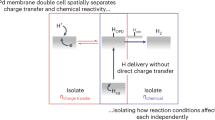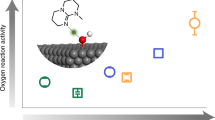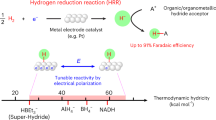Abstract
Electrochemical proton-coupled electron transfer (PCET) reactions can proceed via an outer-sphere electron transfer to solution (OS-PCET) or through an inner-sphere mechanism by interfacial polarization of surface-bound active sites (I-PCET). Although OS-PCET has been extensively studied with molecular insight, the inherent heterogeneity of surfaces impedes molecular-level understanding of I-PCET. Herein we employ graphite-conjugated carboxylic acids (GC-COOH) as molecularly well-defined hosts of I-PCET to isolate the intrinsic kinetics of I-PCET. We measure I-PCET rates across the entire pH range, uncovering a V-shaped pH-dependence that lacks the pH-independent regions characteristic of OS-PCET. Accordingly, we develop a mechanistic model for I-PCET that invokes concerted PCET involving hydronium/water or water/hydroxide donor/acceptor pairs, capturing the entire dataset with only four adjustable parameters. We find that I-PCET is fourfold faster with hydronium/water than water/hydroxide, while both reactions display similarly high charge transfer coefficients, indicating late proton transfer transition states. These studies highlight the key mechanistic distinctions between I-PCET and OS-PCET, providing a framework for understanding and modelling more complex multistep I-PCET reactions critical to energy conversion and catalysis.

This is a preview of subscription content, access via your institution
Access options
Access Nature and 54 other Nature Portfolio journals
Get Nature+, our best-value online-access subscription
$29.99 / 30 days
cancel any time
Subscribe to this journal
Receive 12 print issues and online access
$259.00 per year
only $21.58 per issue
Buy this article
- Purchase on Springer Link
- Instant access to full article PDF
Prices may be subject to local taxes which are calculated during checkout






Similar content being viewed by others
Data availability
All data used to support the claims of the main text have been included with this manuscript as a .zip file. Data used to support claims discussed in the Supporting Information can be made available on reasonable request. Source Data are provided with this paper.
Code availability
All scripts used in CV simulation and data fitting are included in a compressed .zip file in the Supplementary Code section.
References
Weinberg, D. R. et al. Proton-coupled electron transfer. Chem. Rev. 112, 4016–4093 (2012).
Warren, J. J., Tronic, T. A. & Mayer, J. M. Thermochemistry of proton-coupled electron transfer reagents and its implications. Chem. Rev. 110, 6961–7001 (2010).
Warburton, R. E., Soudackov, A. V. & Hammes-Schiffer, S. Theoretical modeling of electrochemical proton-coupled electron transfer. Chem. Rev. 122, 10599–10650 (2022).
Reece, S. Y. & Nocera, D. G. Proton-coupled electron transfer in biology: results from synergistic studies in natural and model systems. Annu. Rev. Biochem. 78, 673–699 (2009).
Mora, S. J. et al. Proton-coupled electron transfer in artificial photosynthetic systems. Acc. Chem. Res. 51, 445–453 (2018).
Hammes-Schiffer, S. & Soudackov, A. V. Proton-coupled electron transfer in solution, proteins, and electrochemistry. J. Phys. Chem. B 112, 14108–14123 (2008).
Schreier, M., Yoon, Y., Jackson, M. N. & Surendranath, Y. Competition between H and CO for active sites governs copper-mediated electrosynthesis of hydrocarbon fuels. Angew. Chem. Int. Ed. 57, 10221–10225 (2018).
Nocera, D. G. Proton-coupled electron transfer: the engine of energy conversion and storage. J. Am. Chem. Soc. 144, 1069–1081 (2022).
Singh, C. & Paul, A. Physisorbed hydroquinone on activated charcoal as a supercapacitor: an application of proton-coupled electron transfer. J. Phys. Chem. C 119, 11382–11390 (2015).
Pourbaix, M. Atlas of Electrochemical Equilibria in Aqueous Solutions (National Association of Corrosion Engineers, 1974).
Cobb, S. J., Ayres, Z. J., Newton, M. E. & Macpherson, J. V. Deconvoluting surface-bound quinone proton coupled electron transfer in unbuffered solutions: toward a universal voltammetric pH electrode. J. Am. Chem. Soc. 141, 1035–1044 (2019).
Ryu, J., Wuttig, A. & Surendranath, Y. Quantification of interfacial pH variation at molecular length scales using a concurrent non-Faradaic reaction. Angew. Chem. Int. Ed. 57, 9300–9304 (2018).
Wesley, T. S., Román-Leshkov, Y. & Surendranath, Y. Spontaneous electric fields play a key role in thermochemical catalysis at metal−liquid interfaces. ACS Cent. Sci. 7, 1045–1055 (2021).
Howland, W. C., Gerken, J. B., Stahl, S. S. & Surendranath, Y. Thermal hydroquinone oxidation on Co/N-doped carbon proceeds by a band-mediated electrochemical mechanism. J. Am. Chem. Soc. 144, 11253–11262 (2022).
Costentin, C., Robert, M., Savéant, J.-M. & Teillout, A.-L. Concerted proton-coupled electron transfers in aquo/hydroxo/oxo metal complexes: electrochemistry of [OsII(bpy)2 py(OH 2)]2+ in water. Proc. Natl Acad. Sci. USA 106, 11829–11836 (2009).
Madhiri, N. & Finklea, H. O. Potential-, pH-, and isotope-dependence of proton-coupled electron transfer of an osmium aquo complex attached to an electrode. Langmuir 22, 10643–10651 (2006).
Laviron, E. Theoretical study of a 1e, 1H+ surface electrochemical reaction (four-member square scheme) when the protonation reactions are at equilibrium. J. Electroanal. Chem. Interfacial Electrochem. 109, 57–67 (1980).
Tyburski, R., Liu, T., Glover, S. D. & Hammarström, L. Proton-coupled electron transfer guidelines, fair and square. J. Am. Chem. Soc. 143, 560–576 (2021).
Jackson, M. N. et al. Strong electronic coupling of molecular sites to graphitic electrodes via pyrazine conjugation. J. Am. Chem. Soc. 140, 1004–1010 (2018).
Savéant, J. M. & Costentin, C. Elements of Molecular and Biomolecular Electrochemistry: An Electrochemical Approach to Electron Transfer Chemistry (Wiley, 2019).
Jackson, M. N., Pegis, M. L. & Surendranath, Y. Graphite-conjugated acids reveal a molecular framework for proton-coupled electron transfer at electrode surfaces. ACS Cent. Sci. 5, 831–841 (2019).
Jackson, M. N., Jung, O., Lamotte, H.C., & Surendranath, Y. Donor-dependent promotion of interfacial proton-coupled electron transfer in aqueous electrocatalysis ACS Catalysis 9, 3737–3743 (2019).
Jackson, M. N. & Surendranath, Y. Donor-dependent kinetics of interfacial proton-coupled electron transfer J. Am. Chem. Soc. 138, 3228–3234 (2016).
Kaminsky, C. J., Weng, S., Wright, J. et al. Adsorbed cobalt porphyrins act like metal surfaces in electrocatalysis. Nat. Catal. 5, 430–442 (2022).
Hutchison, P., Kaminsky, C. J., Surendranath, Y. & Hammes-Schiffer, S. ACS Central Science 9, 927–936 (2023).
Spiro, M. Interfacial kinetics in solution. Linear free-energy relationships applicable to heterogeneously catalysed reactions in solution. Faraday Discuss. Chem. Soc. 77, 275–286 (1984).
Brønsted, J. N. & Pedersen, K. Die katalytische zersetzung des nitramids und ihre physikalisch-chemische bedeutung. Z. Für Phys. Chem. 108U, 185–235 (1924).
Ledezma-Yanez, I. et al. Interfacial water reorganization as a pH-dependent descriptor of the hydrogen evolution rate on platinum electrodes. Nat. Energy 2, 1–7 (2017).
Kuo, D.-Y., Lu, X., Hu, B., Abruña, H. D. & Suntivich, J. Rate and mechanism of electrochemical formation of surface-bound hydrogen on Pt(111) single crystals. J. Phys. Chem. Lett. 13, 6383–6390 (2022).
Rebollar, L. et al. Beyond adsorption’ descriptors in hydrogen electrocatalysis. ACS Catal. 10, 14747–14762 (2020).
Zheng, J., Sheng, W., Zhuang, Z., Xu, B. & Yan, Y. Universal dependence of hydrogen oxidation and evolution reaction activity of platinum-group metals on pH and hydrogen binding energy. Sci. Adv. 2, e1501602 (2016).
Su, L. et al. Electric-double-layer origin of the kinetic pH effect of hydrogen electrocatalysis revealed by a universal hydroxide adsorption-dependent inflection-point behavior. J. Am. Chem. Soc. 145, 12051–12058 (2023).
Jung, O., Jackson, M. N., Bisbey, R. P., Kogan, N. E. & Surendranath, Y. Innocent buffers reveal the intrinsic pH- and coverage-dependent kinetics of the hydrogen evolution reaction on noble metals. Joule 6, 476–493 (2022).
Prats, H. & Chan, K. The determination of the HOR/HER reaction mechanism from experimental kinetic data. Phys. Chem. Chem. Phys. 23, 27150–27158 (2021).
Li, M. et al. Platinum–water interaction induced interfacial water orientation that governs the pH-dependent hydrogen oxidation reaction. J. Phys. Chem. Lett. 13, 10550–10557 (2022).
Li, P. et al. Hydrogen bond network connectivity in the electric double layer dominates the kinetic pH effect in hydrogen electrocatalysis on Pt. Nat. Catal. 5, 900–911 (2022).
Lamoureux, P. S., Singh, A. R. & Chan, K. pH effects on hydrogen evolution and oxidation over Pt(111): insights from first-principles. ACS Catal. 9, 6194–6201 (2019).
Govindarajan, N., Xu, A. & Chan, K. How pH affects electrochemical processes. Science 375, 379–380 (2022).
Jackson, M. N. & Surendranath, Y. Molecular control of heterogeneous electrocatalysis through graphite conjugation. Acc. Chem. Res. 52, 3432–3441 (2019).
Warburton, R. E. et al. Interfacial field-driven proton-coupled electron transfer at graphite-conjugated organic acids. J. Am. Chem. Soc. 142, 20855–20864 (2020).
Wise, C. F. & Mayer, J. M. Electrochemically determined O–H bond dissociation free energies of NiO electrodes predict proton-coupled electron transfer reactivity. J. Am. Chem. Soc. 141, 14971–14975 (2019).
Gum, W. F. & Joullié, M. M. Structure vs. reactivity in quinoxalinecarboxylic acids and esters. J. Org. Chem. 30, 3982–3985 (1965).
Armstrong, F. A. et al. Fast voltammetric studies of the kinetics and energetics of coupled electron-transfer reactions in proteins. Faraday Discuss. 116, 191–203 (2000).
Hirst, J. & Armstrong, F. A. Fast-scan cyclic voltammetry of protein films on pyrolytic graphite edge electrodes: characteristics of electron exchange. Anal. Chem. 70, 5062–5071 (1998).
Feldberg, S. W. & Rubinstein, I. Unusual quasi-reversibility (UQR) or apparent non-kinetic hysteresis in cyclic voltammetry: an elaboration upon the implications of N-shaped free energy relationships as explanation. J. Electroanal. Chem. Interfacial Electrochem. 240, 1–15 (1988).
Laviron, E. General expression of the linear potential sweep voltammogram in the case of diffusionless electrochemical systems. J. Electroanal. Chem. Interfacial Electrochem. 101, 19–28 (1979).
Costentin, C., Robert, M., Savéant, J.-M. & Teillout, A.-L. Concerted and stepwise proton-coupled electron transfers in aquo/hydroxo complex couples in water:oxidative electrochemistry of [OsII(bpy)2(py)(OH2)]2+. ChemPhysChem 10, 191–198 (2009).
Ryu, J. & Surendranath, Y. Tracking electrical fields at the Pt/H2O Interface during hydrogen catalysis. J. Am. Chem. Soc. 141, 15524–15531 (2019).
Markle, T. F., Darcy, J. W. & Mayer, J. M. A new strategy to efficiently cleave and form C–H bonds using proton-coupled electron transfer. Sci. Adv. 4, eaat5776 (2018).
Bourrez, M., Steinmetz, R., Ott, S., Gloaguen, F. & Hammarström, L. Concerted proton-coupled electron transfer from a metal–hydride complex. Nat. Chem. 7, 140–145 (2015).
Morris, W. D. & Mayer, J. M. Separating proton and electron transfer effects in three-component concerted proton-coupled electron transfer reactions. J. Am. Chem. Soc. 139, 10312–10319 (2017).
Chan, K. & Nørskov, J. K. Potential dependence of electrochemical barriers from ab initio calculations. J. Phys. Chem. Lett. 7, 1686–1690 (2016).
Kresge, A. J. The Brønsted relation—recent developments. Chem. Soc. Rev. 2, 475–503 (1973).
Acknowledgements
We gratefully acknowledge C. Costentin for fruitful discussions. We thank the entire Surendranath laboratory for their support and scientific discussions, with particular acknowledgment towards B. Tang, N. Razdan, S. Weng, A. Chu, M. Pegis and H. Wang for their helpful discussions. This research was supported by the US Department of Energy, Office of Basic Energy Sciences, under award no. DE-SC0020973 (N.B.L. and Y.S.).
Author information
Authors and Affiliations
Contributions
N.B.L. and Y.S. conceived the research and developed experiments. N.B.L conducted all experiments and data analysis. N.B.L, Y.S., R.P.B. and A.V.S. developed I-PCET kinetic model. N.B.L., R.P.B. and K.S.W developed scripts for data simulation and fitting. N.B.L. and Y.S. wrote the manuscript with input from all authors.
Corresponding author
Ethics declarations
Competing interests
The authors declare no competing interests.
Peer review
Peer review information
Nature Chemistry thanks Zhongbin Zhuang and the other, anonymous, reviewer(s) for their contribution to the peer review of this work.
Additional information
Publisher’s note Springer Nature remains neutral with regard to jurisdictional claims in published maps and institutional affiliations.
Supplementary information
Supplementary Information
Supplementary Notes 1–8, Datasets 1–6, Figs. 1–15, and Tables 1 and 2.
Supplementary Data 1
A .zip file containing tabulated source data for Figs. 1–6, as well as raw CVs used to create Pourbaix Diagram in Fig. 3 and to create all Trumpet plots comprising the data in Figs. 4–6.
Supplementary Code 1
MATLAB scripts used to simulate and fit trumpet plots.
Source data
Source Data Fig. 3
Panel a: slow scan rate cyclic voltammogram of GC-COOH in pH 14. Panel b: equilibrium potential of GC-COOH I-PCET as a function of solution pH.
Source Data Fig. 4
Panel a: fast-scan-rate cyclic voltammogram of GC-COOH in pH 14. Panel b: trumpet plots for GC-COOH I-PCET at pHs 0, 7 and 14, with simulated fits.
Source Data Fig. 5
Apparent rate constant data of I-PCET at GC-COOH extracted from trumpet plots as a function of pH.
Source Data Fig. 6
Apparent rate constant data of I-PCET at GC-COOH extracted from trumpet plots as a function of pH with fits from mechanistic model for the ‘acid’ and ‘base’ reactions and their overall sum.
Rights and permissions
Springer Nature or its licensor (e.g. a society or other partner) holds exclusive rights to this article under a publishing agreement with the author(s) or other rightsholder(s); author self-archiving of the accepted manuscript version of this article is solely governed by the terms of such publishing agreement and applicable law.
About this article
Cite this article
Lewis, N.B., Bisbey, R.P., Westendorff, K.S. et al. A molecular-level mechanistic framework for interfacial proton-coupled electron transfer kinetics. Nat. Chem. 16, 343–352 (2024). https://doi.org/10.1038/s41557-023-01400-0
Received:
Accepted:
Published:
Issue Date:
DOI: https://doi.org/10.1038/s41557-023-01400-0
This article is cited by
-
Molecularly defined electrodes host a concert of protons and electrons
Nature Chemistry (2024)



